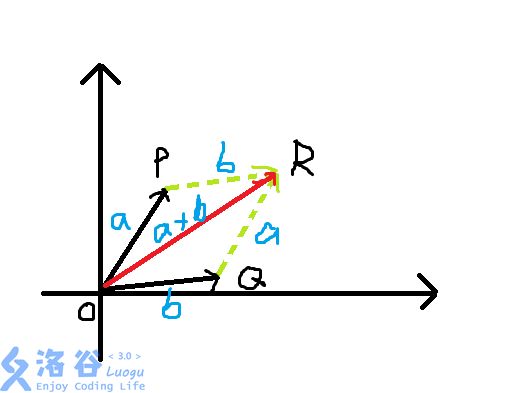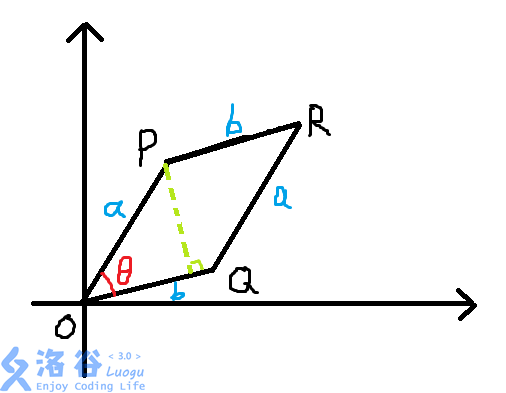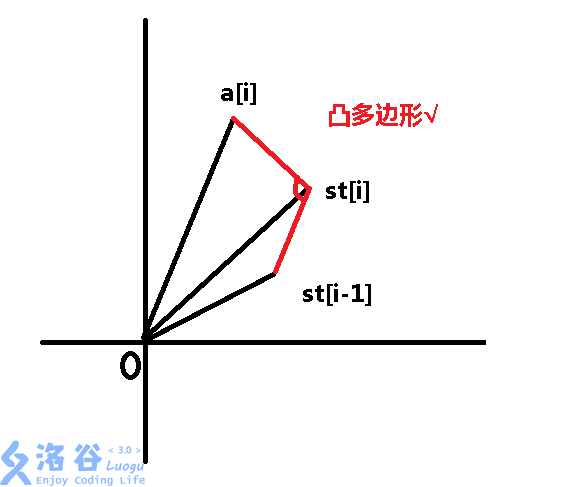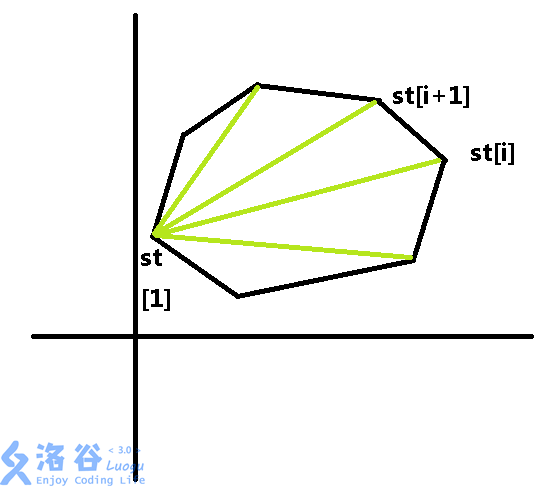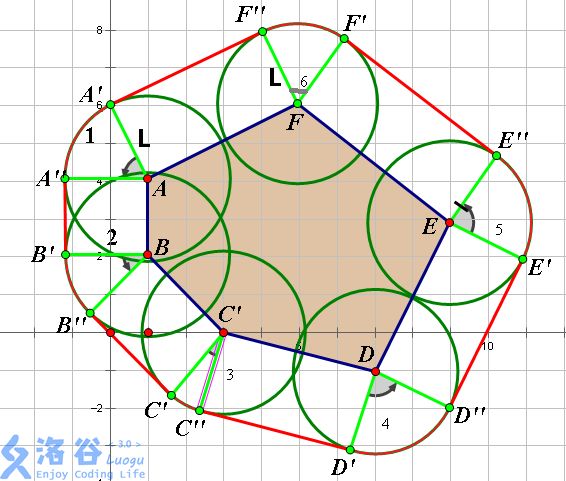矢量&凸包学习笔记
矢量&凸包学习笔记
矢量
矢量(向量)的定义和表示法
定义:一条有方向的线段。
表示:如下图。
那么我们把这一条矢量写作: A B → \overrightarrow{AB} AB,它的长度为 a a a,记作 ∣ A B → ∣ \left|\overrightarrow{AB}\right| ∣∣∣AB∣∣∣。
矢量的运算
矢量的加减遵循三角形法则。
加:
根据三角形法则, ∣ A C → ∣ = ∣ A B → ∣ + ∣ B C → ∣ = a + b \left|\overrightarrow{AC}\right|=\left|\overrightarrow{AB}\right|+\left|\overrightarrow{BC}\right|=a+b ∣∣∣AC∣∣∣=∣∣∣AB∣∣∣+∣∣∣BC∣∣∣=a+b 。
减:
∵ ∣ B C → ∣ = b \because \left|\overrightarrow{BC}\right|=b ∵∣∣∣BC∣∣∣=b
∴ ∣ C B → ∣ ( ∣ B C ← ∣ ) = − b \therefore \left|\overrightarrow{CB}\right|(\left|\overleftarrow{BC}\right|)=-b ∴∣∣∣CB∣∣∣(∣∣∣BC∣∣∣)=−b
∴ ∣ B C ′ → ∣ = − b \therefore \left|\overrightarrow{BC'}\right|=-b ∴∣∣∣BC′∣∣∣=−b
∴ ∣ A C ′ → ∣ = ∣ A B → ∣ + ∣ B C ′ → ∣ = a + ( − b ) = a − b \therefore \left|\overrightarrow{AC'}\right|=\left|\overrightarrow{AB}\right|+\left|\overrightarrow{BC'}\right|=a+(-b)=a-b ∴∣∣∣AC′∣∣∣=∣∣∣AB∣∣∣+∣∣∣BC′∣∣∣=a+(−b)=a−b(三角形加法法则)
矢量的乘法遵循平行四边形法则。
如图,以矢量 O P → \overrightarrow{OP} OP、 O Q → \overrightarrow{OQ} OQ为邻边作平行四边形 O P R Q OPRQ OPRQ。
根据三角形法则,可得 ∣ O R → ∣ = a + b \left|\overrightarrow{OR}\right|=a+b ∣∣∣OR∣∣∣=a+b。
我们不妨设 P P P就为 O P → \overrightarrow{OP} OP, Q Q Q就为 O Q → \overrightarrow{OQ} OQ。
则定义 P × Q P \times Q P×Q( P P P叉乘 Q Q Q(不是点乘( ∙ \bullet ∙)))为:
P × Q = S O P R Q = a × b × sin ( θ ) P \times Q=S_{OPRQ}=a \times b \times \sin(\theta) P×Q=SOPRQ=a×b×sin(θ)
当 O O O为坐标原点时,也可以表示为:
P × Q = ∣ x 1 y 1 x 2 y 2 ∣ = x 1 y 2 − x 2 y 1 P \times Q = \begin{vmatrix}x_1 & y_1 \\x_2 & y_2\end{vmatrix}=x_1y_2-x_2y_1 P×Q=∣∣∣∣x1x2y1y2∣∣∣∣=x1y2−x2y1
由此也可得 P × Q = − ( Q × P ) P\times Q=-(Q\times P) P×Q=−(Q×P)。
同时可以通过 P × Q P\times Q P×Q的值的正负求出 P P P、 Q Q Q的对应位置。
- 当 P × Q > 0 P\times Q>0 P×Q>0时, P P P在 Q Q Q的顺时针方向。
- 当 P × Q < 0 P\times Q<0 P×Q<0时, P P P在 Q Q Q的逆时针方向。
- 当 P × Q = 0 P\times Q=0 P×Q=0时, O P → \overrightarrow{OP} OP与 O Q → \overrightarrow{OQ} OQ共线。
凸包
1.模板
例题:P2742 【模板】二维凸包 / [USACO5.1]圈奶牛Fencing the Cows
题意:给一些点,求凸包周长。
做法: G r a h a m Graham Graham:
先通过 s o r t sort sort求出平面中最左下的点,然后以它为原点对其它点做极角排序,然后按极角从小到大依次插入一个 s t a c k stack stack中,每一次插入前看是否满足 s t a c k stack stack中的点和插入后的点是一个凸多边形:如是,就插入;否则一直 p o p pop pop直到满足条件为止。
最后 s t a c k stack stack中的点就是凸包的顶点。
那么如何判断 s t a c k stack stack中的点和插入后的点是否是一个凸多边形呢:
当 c r o s s ( s t [ t o p − 1 ] , s t [ t o p ] , a [ i ] ) > 0 cross(st[top-1],st[top],a[i])>0 cross(st[top−1],st[top],a[i])>0时,根据右手法则,意味着由 s t [ i − 1 ] st[i-1] st[i−1]、 s t [ i ] st[i] st[i]、 a [ i ] a[i] a[i]组成的图形是这样的:
而当 c r o s s ( s t [ t o p − 1 ] , s t [ t o p ] , a [ i ] ) < = 0 cross(st[top-1],st[top],a[i])<=0 cross(st[top−1],st[top],a[i])<=0时,那么根据右手法则,意味着由 s t [ i − 1 ] st[i-1] st[i−1]、 s t [ i ] st[i] st[i]、 a [ i ] a[i] a[i]组成的图形是这样的:
代码如下:
#include2.面积
例题:poj3348 cows
题意:给一些点,求凸包的面积除以 50 50 50。
做法:我们可以先把一个凸包分割一下:
那么凸包面积就为所示所有三角形之和。
而每个三角形的面积即以三角形的两条绿线(在边界状态下,有1条绿线为黑线)为邻边的平行四边形的面积的一半。
即 c r o s s ( s t [ 1 ] , s t [ i ] , s t [ i + 1 ] ) / 2.0 cross(st[1],st[i],st[i+1])/2.0 cross(st[1],st[i],st[i+1])/2.0。(平行四边形法则)
代码如下:
#include3.隐秘的凸包
例题:P2116城墙/poj1113 Wall
题意:自己看题
做法:我们自己画一下图,就可以发现最小长度总是凸包周长+一个半径为 L L L的圆的周长。
具体证明:
以凸包为 6 6 6边形为例:
如图,我们以每条边作长为边长,宽为 L L L的矩形。
则红线部分就是所求答案。
对于 A ′ ′ B ′ + B ′ ′ C ′ + C ′ ′ D ′ + D ′ ′ E ′ + E ′ ′ F ′ + F ′ ′ A ′ A''B'+B''C'+C''D'+D''E'+E''F'+F''A' A′′B′+B′′C′+C′′D′+D′′E′+E′′F′+F′′A′,我们可以知道它就是 A B + B C + C D + D E + E F + F A AB+BC+CD+DE+EF+FA AB+BC+CD+DE+EF+FA,即凸包周长。
而对于剩下的几段圆弧,我们先经倒角后发现 ∠ 1 + ∠ 2 + ∠ 3 + ∠ 4 + ∠ 5 + ∠ 6 = 36 0 ο \angle1+\angle2+\angle3+\angle4+\angle5+\angle6=360^{\operatorname{\omicron}} ∠1+∠2+∠3+∠4+∠5+∠6=360ο。
那么 A ′ A ′ ′ ⌢ + B ′ B ′ ′ ⌢ + C ′ C ′ ′ ⌢ + D ′ D ′ ′ ⌢ + E ′ E ′ ′ ⌢ + F ′ F ′ ′ ⌢ = C = 2 π r = 2 × a c o s ( − 1 ) × L \overset{\frown}{A'A''}+\overset{\frown}{B'B''}+\overset{\frown}{C'C''}+\overset{\frown}{D'D''}+\overset{\frown}{E'E''}+\overset{\frown}{F'F''}=C=2\pi r=2\times acos(-1)\times L A′A′′⌢+B′B′′⌢+C′C′′⌢+D′D′′⌢+E′E′′⌢+F′F′′⌢=C=2πr=2×acos(−1)×L
对于 n n n边形凸包也是如此。
代码如下:
#include4.练习
poj2007 Scrambled Polygon 模板,极角排序
P3829 [SHOI2012]信用卡凸包 总长=所有圆心的凸包周长+一个圆周长
poj1228 Grandpa’s Estate 稳定凸包。如果每边3点共线,说明凸包稳定,否则不稳定。
P1742 最小圆覆盖/P2533 [AHOI2012]信号塔 最小圆覆盖:随机增量法



